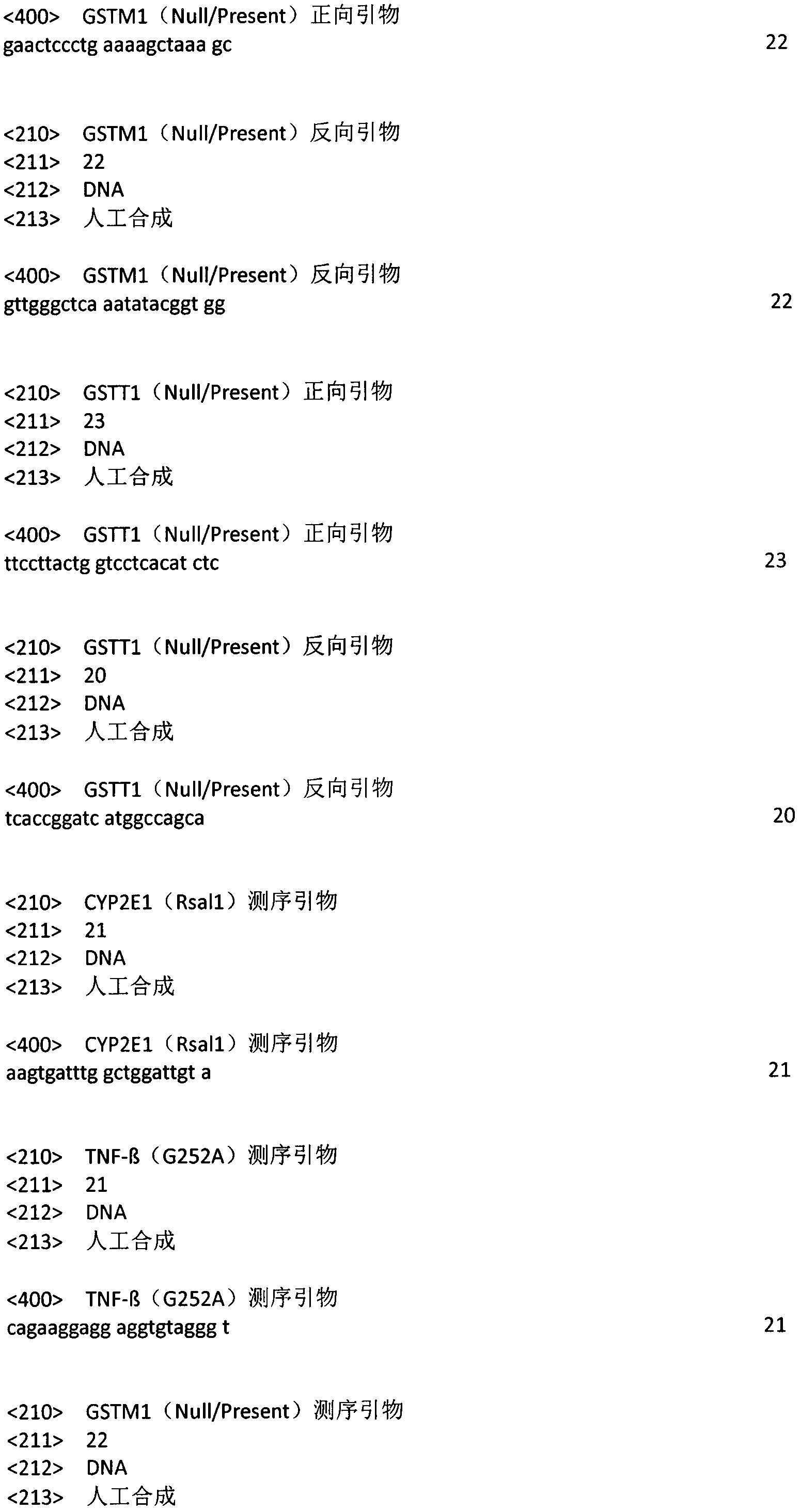Noninvasive detection kit for nasopharyngeal carcinoma susceptibility genes
A detection kit and susceptibility gene technology, applied in the field of molecular biology, can solve the problems of increasing and increasing the concentration of environmental toxins and carcinogens, and lack of polymorphism in the population.
- Summary
- Abstract
- Description
- Claims
- Application Information
AI Technical Summary
Problems solved by technology
Method used
Image
Examples
Embodiment 1
[0020] Example 1. Use of detection kits
[0021] 1. Extract DNA template
[0022] The epithelial cells of the oral mucosa of the subjects were scraped, and the genomic DNA was extracted by the phenol-chloroform method.
[0023] 2. PCR amplification reaction
[0024] Use the PCR reaction component in the detection kit, which contains the following primer pairs:
[0025] (1) CYP2E1 (Rsal1) forward primer: 5′AAGTGATTTGGCTGGATTGTA3′
[0026] CYP2E1 (Rsal1) reverse primer: 5'ATACAGACCCTCTTCCACCTT3'
[0027] (2) TNF-β (G252A) forward primer: 5'CAGAAGGAGGAGGTGTAGGGT3'
[0028] TNF-β (G252A) reverse primer: 5'TTCGTGCTTTGGACTACCG3'
[0029] (3) GSTM1 (Null / Present) forward primer: 5'GAACTCCCTGAAAAGCTAAAGC3'
[0030] GSTM1 (Null / Present) reverse primer: 5'GTTGGGCTCAAATACGGTGG3'
[0031] (4) GSTT1 (Null / Present) forward primer: 5'TTCCTTACTGGTCCTCACATCTC3'
[0032] GSTT1 (Null / Present) reverse primer: 5′TCACCGGATCATGGCCAGCA3′
[0033] The reaction system of PCR amplif...
Embodiment 2
[0049] Example 2. The service of non-invasive detection of genes for the prevention of nasopharyngeal carcinoma
[0050] 1. Sampling and DNA extraction
[0051] The physicians in the laboratory department of the hospital will guide the subjects to use oral swabs to sample oral epithelial cells, and use the phenol-chloroform method to extract DNA from oral epithelial cells
[0052] 2. Genotype detection
[0053] Using the kit provided by the present invention, the Rsal1 polymorphism on the CYP2E1 gene of the subject's genomic DNA, the G252A site polymorphism on the TNF-β gene, whether the GSTM1 gene is missing (Present / Null), the GSTT1 gene deletion and No (Present / Null) 4 single nucleotide polymorphism loci were subjected to DNA sequencing respectively to determine the genotypes of these 4 SNPs loci.
[0054] 3. Risk assessment of high-risk groups for nasopharyngeal carcinoma
[0055] Through the analysis of the SNPs genotypes of the subjects, a risk assessment and analysis...
PUM
 Login to View More
Login to View More Abstract
Description
Claims
Application Information
 Login to View More
Login to View More - R&D
- Intellectual Property
- Life Sciences
- Materials
- Tech Scout
- Unparalleled Data Quality
- Higher Quality Content
- 60% Fewer Hallucinations
Browse by: Latest US Patents, China's latest patents, Technical Efficacy Thesaurus, Application Domain, Technology Topic, Popular Technical Reports.
© 2025 PatSnap. All rights reserved.Legal|Privacy policy|Modern Slavery Act Transparency Statement|Sitemap|About US| Contact US: help@patsnap.com



